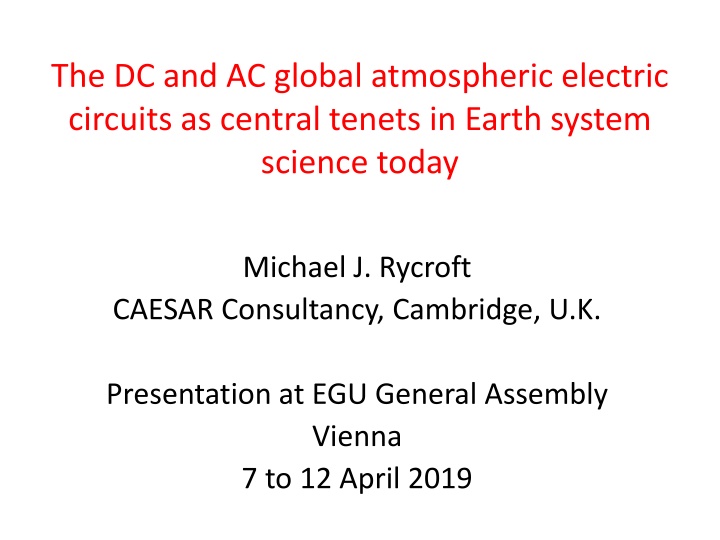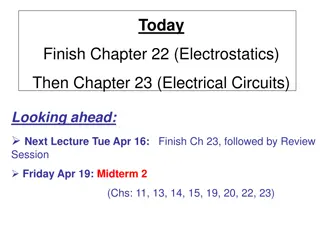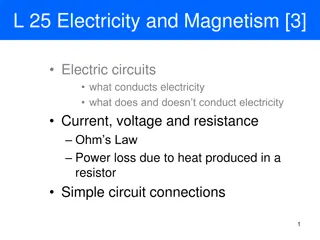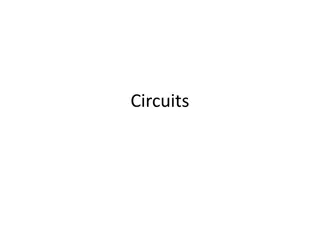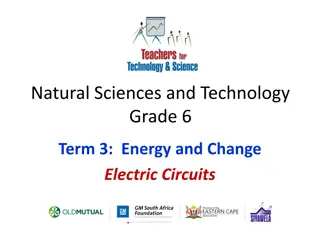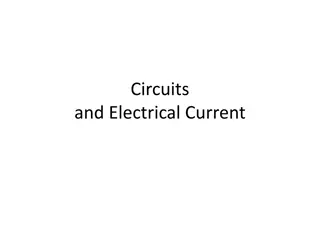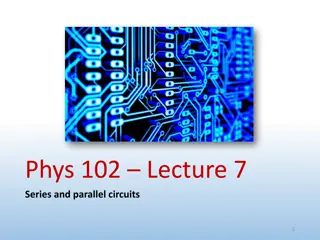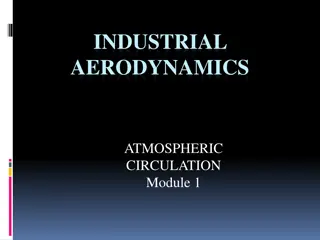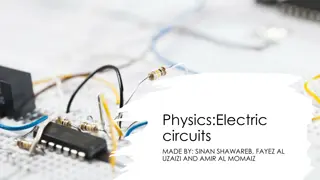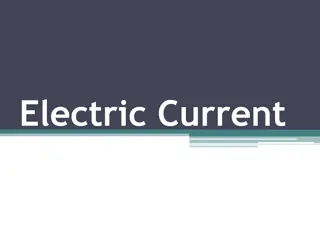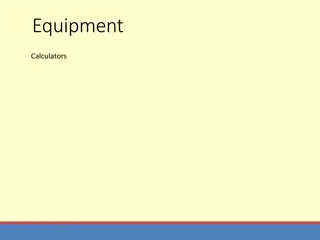The DC and AC global atmospheric electric circuits as central tenets in Earth system science today
The presentation at the EGU General Assembly highlighted the significance of DC and AC global atmospheric electric circuits in Earth system science. Key references from 2007 to 2018 underscore the evolving research in this field, exploring the interconnectedness between the space environment and the troposphere. Various models and simulations shed light on the complex dynamics of the global electric circuit and its impact on atmospheric processes.
Download Presentation

Please find below an Image/Link to download the presentation.
The content on the website is provided AS IS for your information and personal use only. It may not be sold, licensed, or shared on other websites without obtaining consent from the author.If you encounter any issues during the download, it is possible that the publisher has removed the file from their server.
You are allowed to download the files provided on this website for personal or commercial use, subject to the condition that they are used lawfully. All files are the property of their respective owners.
The content on the website is provided AS IS for your information and personal use only. It may not be sold, licensed, or shared on other websites without obtaining consent from the author.
E N D
Presentation Transcript
The DC and AC global atmospheric electric circuits as central tenets in Earth system science today Michael J. Rycroft CAESAR Consultancy, Cambridge, U.K. Presentation at EGU General Assembly Vienna 7 to 12 April 2019
Our true lover of knowledge naturally strives for truth , Plato, 380 BC
Some key references, 2007 - 2018 K.L. Aplin, R.G. Harrison and M.J. Rycroft, Investigating Earth s atmospheric electricity: a role model for planetary studies, Space Sci. Rev. 137, 11-27, 2008 A.J.G. Baumgartner, J. P. Thayer, R. R. Neely III and G. Lucas, Toward a comprehensive global electric circuit model: Atmospheric conductivity and its variability in CESM1(WACCM) model simulations, J. Geophys. Res. 118, 9221-9232, doi:10.1002/jgrd.50725, 2013 V. Bayona, N. Flyer, G. M. Lucas and A. J. G. Baumgaertner, A 3-D RBF-FD solver for modeling the atmospheric global electric circuit with topography (GEC-RBFFD v1.0), Geosci. Model Dev. 8, 3007 3020, 2015 V. V. Denisenko, M. J. Rycroft and R. G. Harrison, Mathematical simulation of the ionospheric electric field as a part of the global electric circuit, Surv. Geophys. 39, 1-35, 2018 R. P. Feynman, Electricity in the atmosphere, Feynman lectures on physics, volume 2, chapter 9, J. Jansky and V. P. Pasko, Charge balance and ionospheric potential dynamics in time- dependent global electric circuit model, J. Geophys. Res. 119, doi: 10.1002/2014JA020326, 2014 J. Jansky and V. P. Pasko, Effects of conductivity perturbations in time-dependent global electric circuit model, J. Geophys. Res. 120, 10654-10668, 2015 J. Jansky, G.M. Lucas, C. Kalb, V. Bayona, M.J. Peterson, W. Deierling, N. Flyer and V.P. Pasko, Analysis of the diurnal variation of the global electric circuit obtained from different numerical models, J. Geophys. Res. 122, 12,906-12,917, 2017 I.G. Kudintseva, A.P. Nickolaenko, M.J. Rycroft and A. Odzimek, AC and DC global electric circuit properties and the height profile of atmospheric conductivity, Annals of Geophysics 59, 5, A0545, doi:10.4401/ag-6870, 2016
Some more key references, 2007 - 2018 E.A. Mareev and E.M. Volodin, Variation of the global electric circuit and ionospheric potential in a global circulation model, Geophys. Res. Lett. 41, 9009-9016, 2014 A. Odzimek, M. Lester and M. Kubicki, EGATEC: A new high resolution engineering model of the global atmospheric electric circuit Currents in the lower atmosphere, J. Geophys. Res. 115, D18207, doi:10.1029/2009JD013341, 2010 M.J. Rycroft, A. Odzimek, N.F. Arnold, M. Fullekrug, A. Kulak and T. Neubert, New model simulations of the global atmospheric electric circuit driven by thunderstorms and electrified shower clouds: the roles of lightning and sprites, J. Atmos. Solar-Terr. Phys. 69, 2485-2509, 2007 M.J. Rycroft and R.G.Harrison, Electromagnetic atmosphere-plasma coupling: The global atmospheric electric circuit, Space Sci. Rev. 168, 363-384, 2012a M.J. Rycroft, K.A. Nicoll, K.L. Aplin and R.G. Harrison, Recent advances in global electric circuit coupling between the space environment and the troposphere, J. Atmos. Solar-Terr. Phys. 90-91, 198-211, 2012b B.A. Tinsley, The global atmospheric electric circuit and its effects on cloud microphysics, Reports on Progress in Physics 71, 066801, 2008 M.A. Uman, The Earth and its atmosphere as a leaky spherical capacitor, American Journal of Physics, 42, 1033-1035, 1974 E.R. Williams, The global electrical circuit: A review, Atmospheric Research 91, 140-152, 2009 E.R. Williams and E.A. Mareev, Recent progress on the global electrical circuit, Atmos. Res. 135-136, 298-227, 2014
Earth system science Considers the Earth s atmosphere, biosphere, surface and oceans - supporting humankind - as a closely interacting system G. Bloschl, H. Thybo and H. Savenije, A voyage through scales: The Earth system in space and time, EGU, 2015, ISBN 978-3-901753-84-8 M. J. Rycroft and R. G. Harrison, Electromagnetic atmosphere-plasma coupling: The global electric circuit, Space Sci. Rev. 168, 363-384, 2012 J. E. Borovsky and J. A. Valdivia, The Earth s magnetosphere: A systems science overview and assessment, Surv. Geophys. 39, 817-859, 2018
Model of DC global atmospheric electric circuit Rycroft et al., JASTP, 62, 1563-1576, 2000
Average model of the height profile of the night-time atmospheric electric conductivity Rycroft et al. JASTP, 69, 2485-2509, 2007
Conductance of the Earths atmosphere Denisenko, Rycroft and Harrison, Surv. Geophys. 40, 1-39, 2019
Modifying the ionosphere above thunderstorms Sprites and elves (transient luminous events) modify the ionospheric electron density X.-M. Shao, E.H. Lay and A.R. Jacobson, Reduction of electron density in the night-time lower ionosphere in response to a thunderstorm, Nature Geoscience 2012, doi: 10.1038/NGEO1668 C.J. Rodger, M. Cho, M.A. Clilverd and M.J. Rycroft, Lower ionospheric modification by lightning-EMP: Simulation of the nighttime ionosphere over the United States, Geophys. Res. Lett. 28, 199-202, 2001 Electron density increases M.A. Salem, N. Liu and H.K. Rassoul, Modification of the lower ionospheric conductivity by thunderstorm electrostatic fields, Geophys. Res. Lett. 2015, doi: 10.1002/2015GL066933 Conductivity decreases but electron density increases Is ionospheric sporadic-E layer enhanced? Investigations by Rastogi (1962), Davis and Johnson (2005), Davis and Lo (2008), Lay et al. (2013), Barta et al. (2015, 2017), Haldoupis (2018)
Ionospheric conductance, 19 UT, July, active Sun Top panel: integral Pedersen conductance Bottom panel: Hall conductance
Return part of global circuit, land/ocean surface, with spatially varying conductivity T. Divett et al., Space Weather 15, 1396-1412, 2017
AC global atmospheric electric circuit Schumann resonances of Earth-ionosphere cavity (8, 14, 20 Hz) (Rycroft, 1965; Simoes et al., 2008) Lowest energy photons in the Universe There is music in the spacing of the spheres , Pythagoras Geo-location of strong lightning discharges Need few observing stations around Earth (Whitley et al., 2011) Q bursts (Ogawa, 1967) produced by the strongest lightning discharges and by sprites Atmospherics (sferics, kHz radiation): lightning detection networks, e.g., WWLLN Hutchins et al. (2014) study thunderstorm contribution to global circuit current using WWLLN data: they estimated 1.1 kA Mezuman et al. (2014) study thunderstorm centres in relation to Carnegie curve, and over oceans Rapid teleconnection of electrical phenomena around global circuit: time constant, tau ~ minutes (DC), 0.1 s (AC)
The DC and AC (fundamental Schumann resonance) global circuit models are consistent R.K. Cole and E.T. Pierce, Electrification in the Earth's atmosphere for altitudes between 0 and 100 kilometers, JGR 70, 2735-2749, 1965. Used ELF radio wave data I.G. Kudintseva, A.P. Nickolaenko, M.J. Rycroft and A. Odzimek, AC and DC global electric circuit properties and the height profile of atmospheric conductivity, Annals of Geophysics 59, 5, A0545, doi:10.4401/ag-6870, 2016. Propose new hybrid model
What is the power available in these circuits ? Power of thunderstorms ~ 100 MV x 1,250 A ~ 1011 W Lightning: global energy dissipation rate ~ 1011 W, according to Sellers (1965) DC circuit Power = 250,000 V x 1,250 A ~ 3 x 108W, ~ 300 MW AC circuit Energy flux, Poynting vector S = E x B/ o = c 0 E2 With EELF~ 1 mV/m, S ~ 3 x 10-9Wm-2 Over area = Earth s diameter x height of ionosphere, energy ~ 1 kW
Fair (and semi-fair) weather model results Rycroft et al., JASTP, 69, 2485-2509,2007 1. Apply Gauss law of electrostatics: in b), Esurface~ 130 V/m 2. In c), note that ~ 90% of the positive electric charge in the atmosphere lies at altitudes BELOW 4 km
C. Haldoupis, M. Rycroft, E. Williams and C. Price Is the Earth-ionosphere capacitor a valid component in the atmospheric global electric circuit? JASTP 164, 127 131, 2017 NO, it is not Positive charge is NOT on the ionosphere; it is distributed through the atmosphere Most charge is near the Earth s surface It is the Earth-atmosphere capacitor that is important Also see Uman (1974)
The Earth-atmosphere capacitor Charge on Earth s surface, Q = 4 RE2 0 Esurface With Esurface~ 130 V/m, Q ~ 5.9 x 105C Charge density on Earth s surface ~ 1 nC m-2 C = Q/V = 5.9 x 105C / 2.5 x 105V ~ 2 F From electrostatics theory, C = 4 0 ab/(b-a) = 4 0 RE2/h, where h = (b-a) For ionosphere, with h = 70 km, C = 0.066 F To have C = 2 F, h = 1 / 4 0 RE2, which is ~ 2 km So it is the Earth-atmosphere capacitor which is important, not the Earth-ionosphere capacitor
Where are the positive charges on the upper plate of the DC global circuit capacitor? On water droplets at tops of stratiform (or layer) clouds, at altitude < 3 km; typically there are ~ 10 electronic charges/droplet Measurements: mean cloud top space charge ~ 30 pC/m3 (Nicoll and Harrison, Q.J.R.Met.S. 142, 2679-2691, 2016) Also charge in clouds themselves (at heights ~ 1 to 4 km) These clouds cover about 40% of the Earth s surface The total charge in these clouds can be shown to be equal and opposite to the charge on the Earth s surface (Harrison et al., in preparation, 2019) Greater charge for lower altitude clouds, with lower conductivity due to reduced cosmic ray ionisation there Link between electrical properties of clouds and cloud microphysics, radiative properties and precipitation, and hence with climate
Climate models including atmospheric electricity L.J. Gray et al., Solar influences on climate, Rev. Geophys. 48, RG4001, 1-53, 2010 E.A. Mareev, Global electric circuit research: achievements and prospects, Phys.-Usp. 53, 504, 2010 E.A. Mareev and E. M. Volodin, Variation of the global electric circuit and ionospheric potential in a general circulation model, Geophys. Res. Lett. 41, 9009 9016, doi:10.1002/2014GL062352, 2014 G. M. Lucas, A. J. G. Baumgaertner and J. P. Thayer, A global electric circuit model within a community climate model, J. Geophys. Res. Atmos. 120, 12,054-12,066, doi:10.1002/2015JD023562, 2015 M.M. Lam and B.A. Tinsley, Solar wind-atmospheric electricity-cloud microphysics connections to weather and climate, J. Atmos. Sol.-Terr. Phys. 149, 277-290, 2016 What are the effects of nuclear explosions, aerosols and dust from volcanoes, and space weather events, on the DC global electric circuit?
Earthquakes, and precursor effects Electrostatic, electrodynamic, electromagnetic or gravity wave effect? R.G. Harrison, K.L. Aplin and M.J. Rycroft, Atmospheric electricity coupling between earthquake regions and the ionosphere J. Atmos. Sol.-Terr. Phys. 72, 376-381, 2010 http://dx.doi.org/10.1016/j.jastp.2009.12.004 L. P. Korsunova, V. Hegai, Y. Mikhailov and S. Smirnov, Regularities in the Manifestation of Earthquake Precursors in the Ionosphere and Near-Surface Atmospheric Electric Fields in Kamchatka, Geomagnetism and Aeronomy 53, 227-233, 2013 R.G. Harrison, K.L. Aplin, M.J. Rycroft, Brief Communication: Earthquake cloud coupling through the global atmospheric electric circuit, Nat. Hazards Earth Syst. Sci. 14, 773-777, doi:10.5194/nhess-14-773-2014 A.P. Nickolaenko and M.Hayakawa, Localized ionospheric disturbance over the earthquake epicentre and modifications of Schumann resonance electromagnetic fields, Geomatics, Natural Hazards and Risk, 5, DOI: 10.1080/19475705.2013.809557, 2014 S. A. Pulinets, D. P. Ouzounov, A. V. Karelin, and D. V. Davidenko, Physical Bases of the Generation of Short Term Earthquake Precursors: A Complex Model of Ionization Induced Geophysical Processes in the Lithosphere Atmosphere Ionosphere Magnetosphere System, Geomagnetism and Aeronomy 55, 521-538, 2015 D. Ouzounov, S. Pulinets, K. Hattori and P. Taylor (eds), Pre-earthquake processes: A multidisciplinary approach to earthquake prediction studies, AGU Geophysical Monograph number 234, John Wiley & Sons Inc., 2018
Heliobiology What is the relationship of ELF radio waves to animal and human health? S. J. Palmer, M. J. Rycroft and M. Cermak, Solar and geomagnetic activity, extremely low frequency magnetic and electric fields and human health at the Earth s surface, Surv. Geophys. 27, 557-595, 2006 N. Filipovic et al., Electromagnetic field investigation on different cancer cell lines, Cancer Cell International 14, DOI: 10.1186/s12935-014-0084-x, 2014 M. Destefanis et al., Extremely low frequency electromagnetic fields affect proliferation and mitochondrial activity of human cancer cell lines, International Journal of Radiation Biology 91, 1-9, 2015, DOI: 10.3109/09553002.2015.1101648 Atmospheric ELF fields protect cells in rats under stress conditions G. Elhalel, C. Price, D. Fixler and A. Shainberg, Cardioprotection from stress conditions by weak magnetic fields in the Schumann Resonance band, Scientific Reports 2019. DOI: 10.1038/s41598-018-36341-z
Gravitational waves due to two colliding black holes, observed 26 December 2015 Gravitational waves are of comparable frequencies to Schumann resonances Can they couple? Z. K. Silagadze, Schumann resonance transients and the search for gravitational waves, Modern Physics Letters A 33, 1850023, 2018 E. Thrane, N. Christensen and R.M.S. Schofield, Correlated magnetic noise in global networks of gravitational-wave detectors: Observations and implications, Phys. Rev. D 87, 123009,2013 I. Kowalska-Leszczynska et al., Class. Quantum Grav. 34, 074002, 2017
Summary and conclusions The DC (powered by thunderstorms and rain clouds) and AC (powered by lightning) electric circuits are central tenets of atmospheric electricity We have consistency between DC and AC global circuit models Huge variability having spatial scales of 1 mm to 1 Gm, and temporal scales of 1 s to 30 years High resolution three dimensional computer models with conductivities varying in space and time in the atmosphere, ionosphere, land, ocean and below thunderstorms are now possible, and should be attempted In what ways is the ionosphere above thunderstorms modified? And how? There is an Earth- atmosphere capacitor, with positive charges being distributed throughout atmosphere, mostly in troposphere, not an Earth-ionosphere capacitor Upper plate of capacitor at height ~ 2 km, at top of stratiform clouds What is the charge on the Earth s surface? Is it 6 x 105 C? Climate models can now include atmospheric electricity Do earthquakes, and their precursors, affect the global electric circuit? How? Do AC electric fields (Schumann resonances) affect human health? Are there links between Schumann resonances and gravitational waves? There are many puzzles, and research opportunities, remaining
